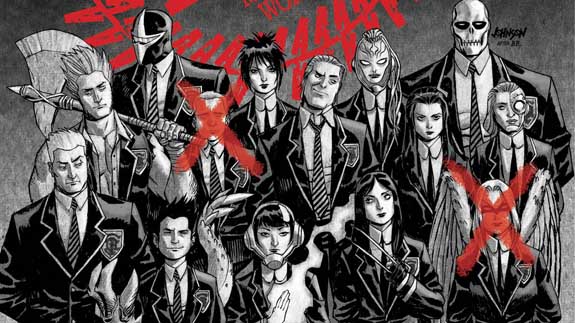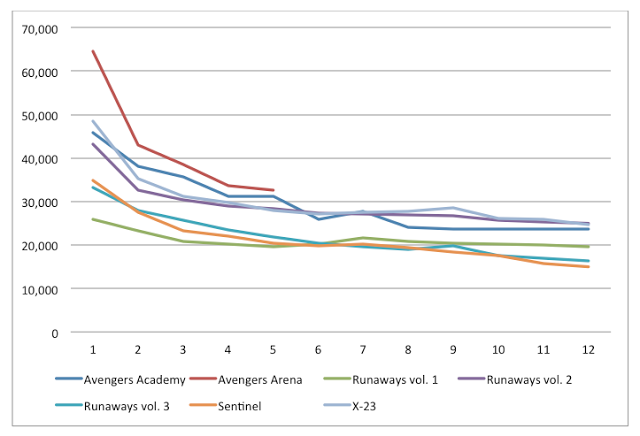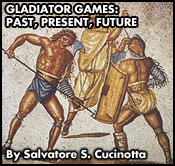 To cash in on the Hunger Games franchise, Marvel Comics announced the series Avengers Arena.
To cash in on the Hunger Games franchise, Marvel Comics announced the series Avengers Arena.
Written by Dennis Hopeless and penciled primarily by Kev Walker, this new ongoing series would have the villain Arcade capture members of critically acclaimed/cult favorite teenage teams (Runaways and Avengers Academy primarily) along with a few others both new and established, and have them participate in a death game akin to Battle Royale (from which it draws the majority of its inspiration).
The reaction garnered was far stronger than almost anything else they announced—to the negative. The author actually received a mixture of cheers and boos as New York Comic-Con before the comic was even released: an extremely rare event.
I believe part of the anger stems from the idea that these characters would be killed off, unlikely to be revived, all for a cheap stunt. It’s happened before, and with characters like these, it’s a constant fear. Often, during a big crossover event, characters like these kids would be killed off to show that some villain is a true threat or that things are now serious. It’s one of the worst things to plague modern comics.
That this is Arcade’s stated goal in this series plays to that fear something fierce.
Curious, I ran a poll across multiple comic websites and forums to gauge the overall reaction to it just on a conceptual level. After getting 311 votes (and dealing with one spammer from Louisiana), I had some rather interesting results.
From this, I concluded that the majority of people who care for the characters, or don’t care, found the idea distasteful to say the least. But online fans are only one segment of the readership, and besides, this was before it was released. Was it any good? By the time of this publication, the first six issues have been released. So, let’s go over it as neutrally as possible (though even I will admit I fell prey to the histrionics it sparked) and see if Avengers Arena is worth the costs.
My apologies to: SF Debris and the Blockbuster Buster for drawing from their respective styles for this review. I’m not a reviewer, I’m an analyst. I look towards deeper meanings whenever I can. Still, I’m going to give it a whirl.
The Good
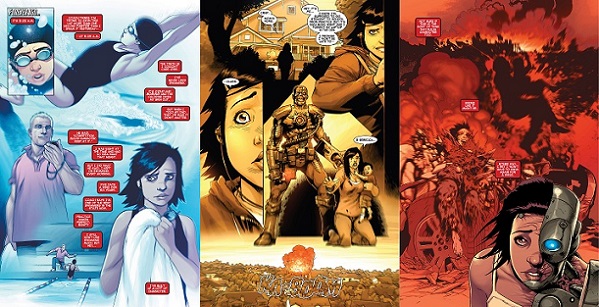 |
| The Secret Origin of Death Locket: A Grandfather Paradox |
Even the most ardent detractors of this series will admit one thing: the art is great. Artist Kev Walker along with colorists Frank Martina and Jean-Francois Beaulieu bring their dark, gritty style to Arena. Thematically, it’s a perfect choice. A death game should not be a clean or pretty thing. It should be messy, dirty and dangerous. The art not only displays that, but gives the characters real humanity and emotive power.
What I find especially entertaining is that the teenagers have bodies that, well, look like teenagers. That may seem like something that should come naturally, but in the world of superhero comics, it’s a rare beast indeed.
There are some problems, of course. The grit in the faces makes several characters look more like old men than teens, and one particular scene in #3 is quite confusing without the accompanying narration, which is a far cry from the smooth and crisp action scenes shown in their work on Thunderbolts, but overall, the art has little to complain about even with the various re-designs.
Several of the new characters, all members of the “Braddock Academy”, have endeared themselves to the readership and I with good reason. The cyborg character Death Locket has a sympathetic backstory that is truly engaging. Then there is the ax-wielding Anachronism, who earned the nickname “Ax-Bro” before his name was even revealed, based on his design alone. His backstory (an introverted, kind gamer who gained the body and half the mind of a bloodthirsty, immortal Celtic warrior) and general attitude has solidified him as one of the stand outs among the new blood.
The others are frankly jerks, which is a necessity of the genre, but only so far. Kid Briton is a jerk jock powered by his own ego, and my god does he have a lot of it. He’s interesting, but repellent in his bravado, an overall good mix for that sort of character. Apex is little different as a self-proclaimed manipulator and a rather utilitarian one at that. Interesting only as more of the truth about her is being revealed. If it was not for the rather ham fisted nature of her introduction and rather odd speech pattern (which at times devolves into a word scramble of internet slang), I’d mark her among the more interesting of the new cast. But to anyone who’s seen any parts of the genre before, these new characters are pretty much marked as dead-kids-walking. Nara lives on the interplay of sex and violence. The only reasonable one left in the group is Bloodstone, who hasn’t had much time to shine, but has shone almost as brightly as the first two I mentioned, acting as Anachronism’s conscience towards the end of the first arc.
The established characters have gotten some time to shine in this series as well. Cammi, a supporting character from Marvel’s space titles, like the Annihilation event, has been remade from a headstrong earth girl unknowingly out of her depth to a 14 year old Boba Fett. Most of the change happens off screen, but the change is built up in backstory rather well. Also, the core perspective taken with Runaways member Chase Stein (amounting largely to a layered survivor’s guilt) is a good take to have and an interesting thing to throw into this genre. It’s believable and a good thing to add to such an event. Unfortunately, it’s one of the few things added to the genre by this story.
The Bad
There are a lot of problems in Avengers Arena; so much so that going into detail on all of them would take all day. So for brevity’s sake, I’ll focus on the most important or heinous of them. The first one comes on the other side of the characterization positives I mentioned.
So far, the series has taken more time to set up the new cast than anything else and the established cast, the ones that got the most hype for it in the first place, are not fairing so well. There’s a lot of them to choose from, but few are well known to the general public (cult hit characters have that problem), so most won’t notice any errors regarding them. Doesn’t make it any less wrong, of course. They don’t even have that many appearances, so I find the lack of research apparent to be rather appalling.
The first issue demonstrates this perfectly, focusing on the character of Hazmat. As her name implies, she has the ability to generate hazardous materials, from neurotoxins to blasts of radiation and EMP. She has to remain constantly in a containment suit as she cannot stop generating the stuff, with the added trauma of first manifesting her powers while making out with her boyfriend. This experience, as well as the isolation and loss of a perfect life as she had, has left her bitter and with anger issues.
Then the first panel of Avengers Arena hit print.
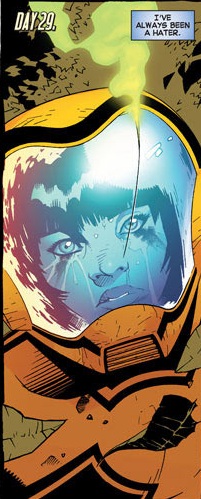 |
| Suspension of Disbelief status: shattered. Also, is that mascara? |
At best, this is a needless retcon (retroactive continuity, or as SF Debris puts it an “Orwellian Dictator’s approach to history”). And at worst, it absolutely undermines her character and her development within her prior series. Either way, it makes her character simpler and shallower as a result. She’s no longer angry because of her condition, but angry as a state of being.
The other cast members don’t fare much better. Powers work in odd ways with only a few getting commentary, past interactions are glossed over to forward the paranoia and suspicion, etc. Now, a new writer coming on board a title often changes things up drastically, and that’s something that can be forgiven by some. But not me of course, I’m a vindictive jerk.
Normally I’d ignore them, but the book so far isn’t that good with its own continuity. The character of Hazmat again takes focus here. Remember, she constantly produces radioactivity and poison. This comes from her sweat, tears and even breath. In the first issue, she gets a cut in her helmet, leaking a foul green air.
This then disappears, flicking as there and not in #2, then disappearing right out until #5.
I’m all for conservation of detail, but you’d think something like that would be important. It stands out all the more prominently when it occurs between the end of #1 and the very start of #2, mostly because they both show the exact same scene. If this keeps up, we could have a drinking game. Another such artistic error occurs in #4, but was corrected in the digital editions, where the artist got the number of claws (and their placement) that Wolverine’s clone X-23 had wrong.
In light of these internal errors, the niceties normally applied to a new writer cannot be provided for Dennis Hopeless and only serve to emphasize the problems of Avengers Arena. There are almost half a dozen other errors like that, and they show no signs of abetting anytime soon.
Another of the larger problems is in regards pacing. Somehow, it manages to be both extremely slow and rushing towards where it needs the characters to be rather than having it grow organically. It is slow in that each issue focuses on a different character and in some cases (like in #4), little of consequence occurs. On the other hand, it rushes towards building stress and tension amidst the groups, glossing over mourning periods and forcing confrontations (again, in #4) when past history suggests otherwise. #3 has an 8 day time skip covered in 3 panels, as a for instance. It’s problematic to say the least, and leads into a greater problem than even the ones I’ve mentioned already.
The Ugly
One of the most important things in all of fiction is to show rather than tell. When doing more in depth analysis of fiction, I will often discount what a character says in favor of looking at what actually happens. Actions speak louder than words and all that jazz.
Avengers Arena doesn’t believe in that. It is loaded to the brim with exposition dumps and many characters telling the audience things about themselves and each other. When the Braddock Academy students are introduced in #2, each one gets a small paragraph telling us a lot about them.
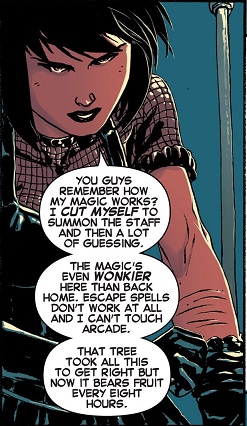 |
| Exposition Dumps: For scenes that would have been really cool to see, but get glossed over. |
The picture above is from #4, which is only one of the several exposition dumps that occur in that issue. It’s a wonderful thing to hear about, but only makes me want to have actually seen the scenes in question. Also from #4 comes one which really could have been taken care of by the artist if Dennis Hopeless trusted them. After an initial confrontation between the Runaways and Avengers Academy Students (which primarily relies on forgetting that they were friendly last time they met), the runaway Chase Stein and academy student Reptil have a talk alone and Repitl mentions that, for a split second while he had the two runaways pinned, he thought about killing them and being done with it, to his horror. It’s a decent moment, but it comes out of nowhere because we don’t really see that line of thought occur in the scene he’s talking about. And it could have been a wonderful thing to add to the scene, but as it stands, it’s a missed opportunity.
The core of this problem, I think, is a lack of trust in the artist. Given I just went on and on about what Kev Walker, Frank Martina and Jean-Francois Beaulieu have done, you can understand the disappointment I have that they aren’t trusted more. Even with fill in artist Allesandro Vitti, the art can stand on its own for the most part, and the overwrought narration and expository dialogue serve only to detract from the experience.
The next unforgivable sin Arena commits is in its game construction. Both Hunger Games and Battle Royale have rather complex game set ups at their core. Battle Royale has its game outlined in precise detail, each new bit of information increasing the hopelessness of the characters plight, all to emphasize the core, which is summarized in the tagline question of Battle Royale: “Could you kill your best friend?” Hunger Games has a game where the spoken rules are simple; the unspoken ones regarding sponsors and public perception and its manipulation are perhaps even more complex than the one in Battle Royale. All of it leading to an idea of disinformation and general distrust of what people are told regarding horrific scenes in a direct corollary to the second Gulf War.
And what does Arena do? Instead, it provides rules which at best can form a vague outline: “Kill each other because Arcade puts a gun to your head, but you have 30 days to do it.” It tries to give a mocking nod to the source material, but game-rules wise, it doesn’t resemble either. There’s no subject directly forcing them to compete like in Battle Royale, and there’s no sponsorship meta-game as in Hunger Games. Here, it’s just “Fight because I say so, you have 30 days!” It’s very droll.
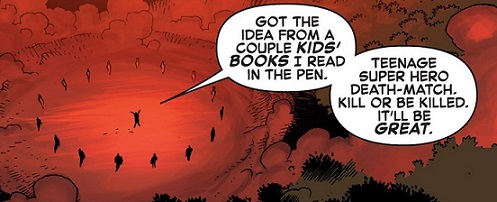 |
| Obviously, if he paid attention to them at all, he would have a tighter setup for his game. |
Arcade outlines the environment, but that has little bearing on the rules of play in the actual game (again, to my disappointment). This is pointed out directly within the series itself, when 10 days in Arcade chastises them all for ‘being boring’ and alters the scenario to make things deadlier. That is a failure on Arcade part, and the writer does not seem to realize it.
Speaking of, the treatment and presentation of the villain is another cardinal sin of Arena. Arcade is, quite frankly, forcefully oversold and overhyped while at the same time displaying a staggering incompetence that makes taking him seriously an arduous task.
Originally, Arcade took his name and mannerisms from old school arcades and funhouses. He builds elaborate and inventive deathtraps for his assassination jobs out of sheer boredom with how easy it is. But when he tries it on super heroes, they thwart them – to his initial amusement. He wanted more of a challenge for his kills.
Though I got to say, his traps were pretty inventive and quite silly overall in his early appearances and what few others I’ve managed to read. I mean, he build giant pinball death machines and once brainwashed X-Man Colossus and made him a super communists under his thrall. He then had Colossus redub himself “The Proletarian”. I don’t think anything more needs to be said. This guy’s always been goofy. It’s evident in his character design.
But as time wore on and he kept losing, he became bitter about it. Arena is his attempt to legitimize himself after decades of failure. It’s so focused on this idea that it ends up coming off as insincere or false. Instead of using his guile and intelligence to build a truly elaborate trap and game, we get an Arcade apparently granted godlike powers and gathering contestants in a self-proclaimed haphazard manner.
I don’t know about anyone else, but the word “haphazard” should not be so easily branded about for a character who builds elaborate deathtraps. If anything, they should be obsessive on the details. Placing these two together, we get a character that is more inept than terrifying. Robbed of his camp and goofy nature, he’s relying not on his wits or preparations, but on raw powers within his new Murderworld (yes, that’s what he calls his deathtraps) in direct contradiction to his initial motives. Worse it’s frankly unnecessary. It does more harm than good in establishing him. It raises questions, but ones that only serve to undermine the core ideas: “How did Arcade get these powers”, “Is this even real”, “Why is he bothering with children when he has such power?”
It paints him as timid, and with an ego as large as Arcade’s, that’s a very strong dichotomy. It’s no wonder that one of the first theories regarding Avengers Arena is that they are all trapped in a VR simulation. In #5, Anachronism even begins to speculate on it.
 |
| 4Chan figured it out rather early. |
This is combined with the comic’s need to make sure the reader believes that Arcade is now a grand threat. It unfortunately does so in a way which is utterly unbelievable. Aside from the above problems, the character Mettle expresses a good deal of fear about confronting him. This occurs after his girlfriend Hazmat was tossed a good deal away by one of Arcade’s attacks during a scene of Arcade beating up on most of the kids at once to establish his new power-up.
That’s all well and good until that pesky bastard called Continuity rears its ugly head. Mettle, during the event Fear Itself, along with Hazmat, went off to what they believed to be certain death to let their friends escape while fighting off two of the God of Fear’s chosen warriors. He’s also faced down two cosmically powered villains: a Phoenix host and Korvak.
And Arcade is somehow scarier? Because he’s “stronger”? I just don’t buy it. But the characters do. For some reason. The prevalence of the “They’re all trapped in VR” theory lends credence to the sheer believability of events so far.
No character disparages Arcade despite having prior history with him (aside from Bloodstone calling him a “dandy nutter”), or the general joke status he garnered. Nothing to contradict the new status-quo. Arcade is a legit threat for no other reason than the writer’s say so. In short: Arcade is a ‘Villain Sue’: a variation of the dreaded Mary Sue trope. I’m loath to brandy about that accusation, but I see little other way to describe a character whose obvious faults are glossed over and is praised for little legitimate reasoning. That the apparent power up is needless to move the overall story forward only compounds the problem. Throw in some bland ‘comedy’ and missed obvious jokes, and we have a recipe for revulsion.
The second to last cardinal sin of the work is the manner in which it has killed. As of this writing, it has killed three characters: Mettle, Red Raven and Kid Briton. Of these, Mettle’s death was more about his girlfriend’s reaction to it (and setting up Arcade’s powers as truly un-opposable by the kids) than himself, and Red Raven’s death makes the deaths of most Red Shirts on Star Trek look like Mercutio in Romeo and Juliet. All for the sake of a sight gag. These are poor deaths primarily because the focus of the story was not on them. Kid Briton’s death is the only one which in anyway gets close to actually being about him. This is primarily because he received focus in the issue prior to his death. In the issue where he does die, it’s primarily about his killer rather than him.
The best deaths in fiction focus not on those who react to it, but on the characters which die, no matter how they die. Be it an ignoble sniper shot out of nowhere, or a grand heroic sacrifice, everything up unto the moment of death, and perhaps even a few moments after, is about the one who dies. Those who carry on the legacy of the death do so for them. In Arena, what buildup we have is shallow to non-existent, and the massive time skips are used to gloss over mourning periods. The deaths have little effect on anything and thus are narratively worthless beyond their initial shock value. Mettle receives no mourning from his girlfriend Hazmat, it’s all implied to have happened off screen, which is about as entertaining as an off screen juggler. We see some hints at it altering her motivations, but that’s about it. It’s a pattern with Arena: present an interesting idea or conflict and resolve it off screen. Worse off is Red Raven, whose death has no one to mourn it at all. She doesn’t even get implied or explicit off screen mourning. She dies and is immediately forgotten.
Kid Briton’s might have more repercussions in the future, but it paints the Braddock kids as his pet characters even more so than anything else. His death was more about his killer being overcome with the primal urges he fights within himself than any development on Briton’s part. Even then, it’s still rather hollow. Given Kid Briton was basically introduced as “the Jerk Jock,” there’s no real sadness when he dies. There’s barely any cheering either. It’s just . . . there. And then an unfunny jab by Arcade destroys any shock value it has.
Mettle’s death is compounded in its overall badness by the other functions it forms in the narrative. He’s blown to bits by Arcade to demonstrate his absolute power over them (there’s that Mary Sue thing again), set the tone for the story and show that he’s really, well and truly dead.
Which most readers responded by thinking “they’re likely trapped in virtual reality” so you can see how well that worked out.
But the final, cardinal sin of Arena is its unoriginality. While attempting an homage to both Hunger Games and Battle Royale (structurally resembling Battle Royale, but using some elements from Hunger Games), it falls flat in comparison to both of them. This is primarily because it does nothing new or very interesting with the concept. Now, while mixing two or more ideas together can create something new and interesting, it’s not a good idea to do so with things which overzealous fans of one accuse the other of plagiarism. The idea of throwing in teen super heroes into the mix so far has produced nothing unique or interesting in the history of the concept. Most of the differences between the Arena and its source materials amount to things which either don’t really matter or are profoundly stupid.
What symbolism I can garner speaks towards the creative practices of Marvel Comics, in an especially negative light, more than anything else: an ancient creative worker struggling for relevance seeking to renew itself through blood sacrifice of budding new ideas. In Hunger Games terms: Marvel is Panem.
Dennis Hopeless stated in interviews that he was working for a ‘High School is Hell’ sort of metaphor, but without the context of a high school for a direct corollary, such as in Buffy the Vampire Slayer, it turns into “Hell is other people” which is ground thoroughly covered by the works he’s drawing on. Battle Royale has a scene (generally known as “The Lighthouse Sequence”) which so encapsulates that idea that having an entire series focusing on that idea as some new twist is honestly laughable.
Remember what I said in the previous article? Even if the ‘hell is other people’ metaphor were to be told well within the scenario, “it really doesn’t fit if there’s a person running it.” What a person does naturally will vary greatly when there’s a metaphoric gun to your head. Battle Royale’s tagline works towards its favor in comparison. “Could you kill your best friend?” is in fact “What would it take to get you to kill your best friend” and to its credit, the scenario is set up so that they can answer the later question. Arena’s simply isn’t up to par.
This leaves only the character exploration to save it from itself, and as I’ve already discussed, that’s a mixed bag. Most of the good work goes to the new kids of the Braddock Academy. Given that originally this was pitched as an arc for a series focusing on them, it stands to reason that this would happen. A reader can see the Braddock series struggling to get out underneath this editorially mandated one. Marvel believed it would sell better.
But would it have?
The Conclusions
As SF Debris said in his review of the Star Trek: Voyager episode “Blink of an Eye”
“How do you rate an episode that is clearly derivative of a more successful work? Well, as I once told a student of mine ‘I don’t grade the paper, I grade the work. Which, in your case, was whiting out the words Microsoft Encarta on every page.“
Judging a work on its original elements is a good litmus to use: new twists to an old idea, how the old ideas are used and overall craftsmanship of characters are all we can really judge it on. As I’ve already described, though its derivative in a negative manner, it does have some good characterization to it and there are a few twists to the scenario set up. In #6, X-23 is exposed to a variant of her “Trigger scent” which, while violating continuity, the definition of the word, and all logic (the damn thing is waters soluble to boot) presents a good twist on the Battle Royale film’s take on Kazuo Kiriyama: the most prolific killer within the game. Here, the killer is there, but she is by nature unwilling and only doing so against her will. It’s implied that she’s also trapped within this behavior, unlike the other times she’s been dosed she is not blacking out. She is in a living hell hunting down her friends and being used as a weapon without her control. Good stuff, should this hold out, but it is speculation. I’m not counting my chickens before they hatch.
On the other hand, Apex is only a mild variation of Battle Royale’s Mitsuko Souma, the most prolific girl killer in the game – using violence and manipulation with equal aplomb. Her heavier reliance on playing others to serve her ends rather than Mitsuko’s more balanced style is the only real difference. The mysteries around her are largely wrapped up in the initial six issues.
Now a lot of this assumes that what we have been presented with is factual as stated. It assumes that there will not be some fake out at the end where the deaths are undone or revealed to not have really happened. With super hero comics, that is possible. However, for characters like this, it is extremely unlikely. So until such a time as it is revealed to have an ‘out’ or it occurs, I have to accept what has happened as having happened rather than living in denial.
 |
| Academy Kids by Max Carleton |
The initial fan reaction to the series mirrors that of the initial NYCC reaction: a mixture of cheers and boos. Online communities are split down the middle, with each board leaning more towards one side or the other seemingly at random. Of the fan-art produced, quite a bit of it speaks out against it. It’s an odd beast: love it or hate it. But I can’t help but think that those who love it would be better served with the source material.
Sales wise, the series started off rather strongly thanks to multiple incentives both advertising wise and store-related discounts. Despite this, it dipped greatly until #5. We won’t really know where it will stand until #7 or so, but the comparisons to what came before are not so great. The initial push did indeed gain a lot of attention, but it quickly dropped to within a thousand of where Avengers Academy was at the same issue. Was it really a good marketing ploy? So far, it was a flash in the pan and that doesn’t look like it’ll change anytime soon.
So, how to rate it? I’ll borrow from SF Debris again here, and take the “Skip it”, “Watchable”, “Recommended”, “Strongly Recommended” and “Must See” approach to the scaling. I’d also throw in a “Burn it” at the very bottom, but we’re not going there now. Weighing all the new work, I have to rate it as “Watchable” (or 2/5). It’s nowhere near as bad as it could have been (Doctor Jekyll’s Dungeon of Death is the current low water mark of just how bad this genre can get), but its character work is not good enough to elevate it above the numerous problems I mentioned and the stumbling theme compared to the core ideas of Runaways and Avengers Academy only emphasizes its shallowness. In its efforts to create entertainment for the readers, it glosses over continuity and even basic logic, undermining the story in the process and mirroring the worst aspects of Michael Bay.
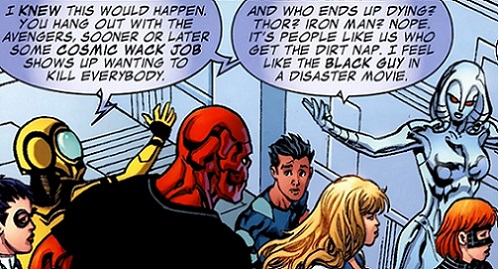 |
| It’s not helped that Avengers Academy repeatedly mocked the idea of a big event killing them all, which is basically Arena in a nutshell. |
It brings to mind a quote from Cicero’s bad review of a show Julius Caesar put on in the ancient Roman Amphitheater:
“What pleasure can there be for a civilized man when either some powerless man is ripped to shreds by a powerful beast or some magnificent animal is transfixed by a spear? But if this show must be viewed, we saw nothing new.”
This quote ends up doing double duty: to describe how Mettle was killed, and how the series holds up. The story works best if the reader is ignorant of the series which the about half the cast is drawn from and/or if the reader never saw Battle Royale before in any of its incarnations. Anyone who has interest in this series is better off reading the prior series and Battle Royale, respectively. I personally prefer the movie version, if only for Takeshi Kitano’s presence.
The best issues of the series are the ones which focus on the original characters or ones which have minimal buildup prior to this series, but the scenario as it stands hinders more than it helps. Hell, if you take the RPG Classroom Deathmatch and plugin the characters here, you’d end up with an overall improvement storytelling wise.
This isn’t a final verdict, but only an analysis of what has been done so far. It wouldn’t be the first time that a series had a weak opening but proved itself later in the run. However, I find this development unlikely. For now, there’s only one thing I see in it’s future.




































































































